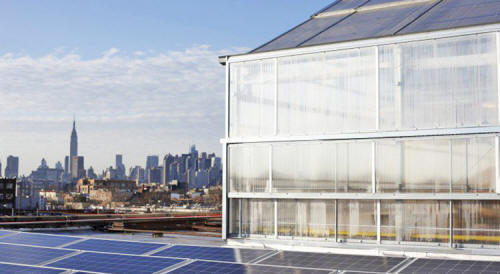|

by Andrew Martin
October 24, 2015
from
Collective-Evolution Website
Spanish version

A Globalized
Food System
The current industrial agricultural model has benefited human
populations (above all else) over the last century, taking the human
population from approximately 1.6 billion people in the early 1900's
to over 7 billion people on 31st of October 2011.
The widespread clearance of land across
all continents for agriculture, combined with the use of heavy
machinery and artificial fertilizers, has contributed to the
widespread exploitation of the planet and ecosystems on a scale
never seen before.
Long Distance
Supply Chains Unsustainable
A study by the Centre for Environmental Studies (CERES) out
of Australia examined how far the average basket of goods travelled
to get to the consumer.
It was established that the basket of
regular goods travelled a total of 70,803 km, equivalent to
travelling nearly twice around the circumference of the Earth
(40,072 km).
The data-collected total greenhouse gas
emissions estimate for all food trucks transporting all
road-transported food items, over the total road transport distance,
was 16, 989 tonnes (t)
CO2-e.
If all the food trucks were transporting
all food items on the same day, the emissions from this one day of
transportation (16, 989 t CO2-e), is equivalent to 4,247 cars
driving for one year. (1)
Increased
Urbanization
According to the UN, more people live globally in urban areas than
in rural areas.
54 per cent of the world's population
resided in urban areas in 2014. In 1950, 30 per cent of the world's
population lived in urban environments. By 2050, it is projected 66
per cent of the world's population will live in an urban setting.
Today, the most urbanized regions of the
world include,
This rapid transformation from rural to
urban has occurred in the last century, correlating with the growth
and exploitation of fossil fuels and the abundance of cheap energy.
(2)
Gotham Greens
to the Rescue
With such a high rate of urbanization in many countries, growing
food in urban settings is going to be a priority over the coming
decades.
Enter, no not Batman, Gotham Greens.
Where others see rooftops, Gotham Greens see green fields, blooming
communities and high quality fresh produce. Gotham Greens designs,
builds, and operates commercial scale greenhouse facilities in urban
areas for fresh vegetable production.
Since commencing production in early
2011, Gotham Greens has quickly become a worldwide pioneer in the
field of urban agriculture and one of New York State's leading
producers of premium-quality, greenhouse-grown vegetables and herbs.
(3)
Gotham Greens was inspired by innovation and technology, driven by a
sense of duty to address ecological issues facing our agricultural
system, and motivated by a farmer's penchant for challenge. Gotham
Greens grows lettuce, basil, bok choy, arugula, swiss chard, and
tomatoes, all from their rooftop facilities.
All the produce is pesticide-free and
grown using ecologically sustainable methods.
Apart from producing highly nutritious
vegetables and herbs, the team at Gotham Greens is serious about
preserving water and soil resources, biodiversity, reducing harmful
chemical use in food production, fair treatment of workers, and
ensuring dollars are spent within the local economy.
-
In 2011 Gotham Greens completed
a 15,000 ft2 facility, the nation's first commercial scale
rooftop greenhouse, producing 100 tons of produce/ year
-
In 2013 Gotham Greens completed
its second rooftop greenhouse, a 20,000 ft' facility on top
of Whole Foods Market Brooklyn, yielding 200 tons of
produce/ year
-
In 2015 Gotham Greens launched
its third rooftop greenhouse in Queens, NYC measuring 60,000
ft2 which will yield approx. approx 625 tons per year
Why is Gotham
Greens Important?
The CEO of Gotham Greens Viraj Puri believes,
“the over-industrialization of
agriculture has led to a huge disconnect between urban consumers
and producers on how food is grown, processed and transported.
By growing locally and regionally,
consumers can better connect and understand their food supply.
Locally grown and supplied can also boost nutrition, create and
jobs and other economic and educational opportunities in our
communities, and encourage consumers to spend their dollars
closer to home.
Addressing food waste is another very important role that urban
agriculture can play.
Long distance transport associated
with trucking food across the country and the food waste that
results is staggering. An estimated 40% of food grown, processed
and transported in the US gets thrown out before it even reaches
our plates!
Last, modern agribusiness relies too heavily on natural
resources like soil, water, and energy and a heavy dependence on
chemical inputs. Local, sustainable agriculture can help address
those issues.
The farming methods at Gotham Greens
use a fraction of the resources compared to conventional
agriculture. Gotham Greens take a holistic approach to growing
practices and use,
-
Non GMO seeds
-
recycled H2O
-
clean energy
All of their produce is pesticide
free and all fertilizer runoff that normally goes into
groundwater (a major source of global water pollution), is
eliminated.” (3a)
The Largest
Rooftop Farm in the World
In 2015 Gotham Greens launched its fourth rooftop greenhouse in
Chicago, IL measuring 75,000ft2 which will produce approx. 1000
tons.
Chicago is also considered “The world's
largest rooftop farm”.
Gotham Greens urban agriculture venture
will sit atop a new manufacturing plant that will also be a global
first. The Method Products facility, which produces nontoxic,
biodegradable natural cleaning supplies, will be the home for this
huge rooftop facility.
It is a win-win for both companies
before even taking into consideration the carbon offsetting benefits
the facility will bring and green credibility for Method Products.
When compared to conventional agriculture, Gotham Greens' irrigation
techniques will use 20 times less land and 10 times less water.
It will also eliminate the need for
pesticide use and fertilizer runoff. (4)
Check out the Gotham Greens operation in Brooklyn:
References
(1)
http://www.theage.com.au/ed_docs/food_miles.pdf
(2)
http://esa.un.org/unpd/wup/Highlights/WUP2014-Highlights.pdf
(3)
http://gothamgreens.com/our-story/
(3a) Personal correspondence with Viraj Puri
CEO Gotham Greens
(4)
http://cleantechnica.com/2014/10/08/urban-agriculture-grows-into-worlds-largest-rooftop-farm/
|


